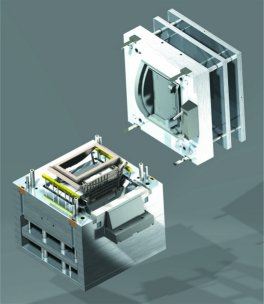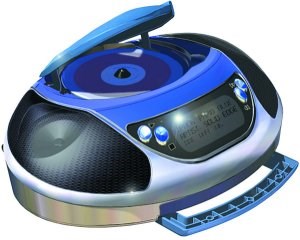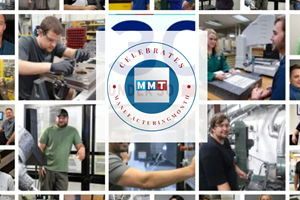Affordable Options Get The Job Done
A host of products and technological advancements allow easier and more efficient mold design and machining without breaking the bank.
Today moldmakers are faced with the never-ending challenge of tightening their belts and - at the same time - offering their customers state-of-the-art molds built more quickly than ever before. In order to remain competitive, the moldmaker must rely on the latest in technology in CAD/CAM systems, which may prove difficult with a smaller budget.
Fortunately, a number of CAD/CAM manufacturers and suppliers have realized that lower-cost options should be available to the moldmaking industry and have developed many products to address this need - which are discussed in detail on the following pages. Additionally, these software providers weigh in on the many advantages that lower-cost options offer, the pros and cons of using less expensive software, tips for choosing the correct affordable software for your shop and what this market has in store for the future.
Lower Cost Developments
According to Brian Kindilien, vice president of Surfware, Inc. (West Lake Village CA) - a CAD/CAM manufacturer - the greatest development with lower-cost products during the past several months has addressed directly their customers' requests to make the manufacturing process more productive overall. "CAD/CAM software providers - Surfware included - have responded by offering a number of enhancements to its products," he states. "We have developed add-on capabilities that can fit into the overall manufacturing process of a machine shop. For example, we have developed a new technology that is designed to improve the bulk material removal process.
"Moldmakers tell us that they are least productive during the bulk material removal process, or roughing," Kindilien continues. "Programming times and machine cycle times absorb valuable man-hours during the roughing phase. By optimizing roughing procedures using best shop practice-style tool selections, and roughing as much material with the largest roughing tools possible, our technology has been shown to increase our moldmaking customers' productivity. The technology also can work with virtually any existing CAD/CAM software solution to optimize the roughing operations in those systems as well - all for a very affordable price. The concept of affordably priced add-on modules that can function in a shop's pre-existing procedures and increase the shop's overall productivity is a huge step toward a bright future."
Automation is the name of the game at Southfield, MI-based Sescoi, Inc. - a provider of automatic manufacturing software solutions. According to Matt Michaels, VP of sales and marketing, incorporating automation features into its offerings takes time out of the entire process - from RFQ (request for quote), design and CAM programming to sample part production and tooling delivery.
Mike Stevens, channel development manager at Coreware, Inc. (Wixom, MI) - the U.S. and Canadian Master distributor of IMOLDT for SolidWorks developed by Manusoft Technologies Pte Ltd. (Singapore) - has seen the following advancements in lower-cost CAD/CAM products: easier Windows-style interfaces, more tools for modeling complex shapes, better management tools within the software to allow for smoother work flow, use of high-speed machining techniques, improved translation from major software solutions, implementation of solids modeling to speed up the design process, and hybrid modeling to allow for surfacing techniques as well as solids.
"In the past, mold designers and moldmakers have had little choice but to use high-cost CAD/CAM systems for their work," Manusoft CEO Victor Gan says, "largely because of the lack of capabilities in low-cost systems - which are usually more 2-D-based - and also a lack of interoperability due to poor quality CAD translators. However, in the last one to two years, some mid-range 3-D CAD systems have come of age, which now can match the high-cost systems in terms of general capabilities and performance."
Mike Paludan, marketing and communications manager for the Solid Edge business at EDS PLM Solutions (Plano, TX) - a global information technology (IT) services company - notes that lower-cost trends include rapid shape creation technology and built-in design management. He also adds his thoughts on the move toward 3-D CAD, "As former 2-D CAD users move to the affordable and highly productive 3-D modeling offered in the mainstream market, they begin creating a very large amount of designs that need to be managed for even further productivity within their organizations."
Bob Fischer, the vice president of sales and marketing at Palm Bay, FL-based VX Corp. - a CAD/CAM developer - notes the company has developed a new tool that "allows users to optimize a 3-D model to achieve a desired design result." For example, plastic bottle designers are required to ensure that their bottle designs hold an exact amount of liquid. This tool plays what-if scenarios to vary constraints, variables and dimensions to produce the required volume. Icon-based interfaces in VX software help provide a user experience that is fluid, efficient and easy-to-learn.
"In general, products priced less than $10,000 have become much more powerful and easier to use," Fischer notes. "For us, this means surfacing, assembly modeling, sketching, mold design and even manufacturing capabilities now rival those of products costing ten times as much."
According to Peter Rucinski, director of product marketing at Moldflow Corp. (Wayland, MA) - a software solutions provider who partners with a number of CAD manufacturers - the company is able to monitor the pulse of the CAD/CAM market through its partnerships in addition to keeping an eye on new entrants into the market. He notes that recently the company has offered some "very tight interfaces" for existing CAD/CAM packages at lower costs. "We have developed technology that makes it very easy for the user to move from the 3-D solid model into plastics flow analysis."
Over at Mastercam/CNC Software, Inc. (Tolland, CT) - a CAD/CAM software provider - marketing manager Ben Mund notes that the company's offerings make it easy for users to upgrade to higher levels at a relatively low cost. "Our milling product has three levels, and the first two offer moldmakers a lower-cost option," he states. "The first is for pretty basic operations like pockets and drilling, the second opens the door to three-axis machining with which one can create sculpted shapes and surfaces - ergonomic things that are not restricted to just 2-D pockets, contours and drilling."
Advantages Aplenty
Among the advantages to using lower-cost software options are less of a learning curve, ease of use and simple maintenance, according to VX's Fischer. "The moldmaker seamlessly can work importing, healing, designing mold components and machining," he notes. "Plus, any changes to the model will be reflected automatically in the mold design and in the machining process."
In addition, Fischer says that the company's software has a very strong native healing function, which is vital to moldmakers who often have to work with imported CAD files - many of which don't automatically translate perfectly into other formats. Also, a new graphical CAM interface allows the designer to create a complete manufacturing plan quickly just by clicking on icons to build the right sequence of actions. "To modify any action, a simple right click calls up a context-sensitive set of options appropriate to that machining routine," Fischer says. "The moldmaker also can save the entire plan or pieces of it and then reuse them and combine them for similar jobs in the future. As time is often money in the moldmaking business, this ability to recycle, combine or easily modify proven routines is valuable."
In agreement is Michaels of Sescoi, who says, "With CAD/CAM tools focused on function specific automation techniques, the tool shop will be able to get jobs built faster in order to meet extremely tight leadtimes."
Expanding on this sentiment is Kindilien of Surfware, who points out that the company's aforementioned technology that automates the rough machining of complex surfaces results in shorter cycle times and higher productivity. "This is a significant enhancement in CAM programming technology that could obviate the need for some currently accepted machining techniques. It raises the programming effectiveness for rough machining to a higher level and should be effective in any application in which complex multiple surfaces are machined," he notes.
Manusoft's Gan adds his thoughts, "Cost and leadtimes for mold delivery have become the most important considerations of molders and product designers in awarding projects to moldmakers. Traditional 2-D mold design requires a longer overall cycle time (from project start to design to complete mold fabrication). The part design also goes through many iterations of changes even while the mold is being designed. Worse, the mold is often designed in one location, fabricated in another and molded (and maintained) in yet another location. Without 3-D design/manufacturing, it is virtually impossible to achieve the data integrity of the design (including the individual components of the mold) necessary to make this happen, as the assembly drawing (models) of the mold must reflect exactly the same information as the individual components. This is very difficult to do in 2-D.
"Moldmaking has come to such a competitive state that achieving high quality and low leadtimes are no longer enough," Gan continues. "Prices are so competitive that often the only way to make money is to reduce the cost of fabricating the mold. This is one area on which our software focuses - helping the designer to design his mold such that it will be cheaper to manufacture."
According to Coreware's Stevens, other important advantages are as follows:
- A wider variety of modeling tools provides the ability to design and manufacture more aesthetically pleasing and complex shapes.
- High-speed machining allows the moldmaker to eliminate processes and reap the benefits of the machine tool - utilizing the new, faster techniques that are needed to cut delivery time.
- Better data translation helps reduce the time and error that occurs in the design chain when dealing with native data.
- With solid modeling, basic shapes and forms can easily be modeled and entered into the design, which along with data associativity more easily allows for engineering changes and process revisions.
- Hybrid modeling gives users the tools to take a complex part designed by a part designer and create a part that can actually be manufactured using a combination of surface and solid modeling techniques.
Rucinski of Moldflow says that some new lower-cost products further streamline the design process. Using some of the company's products allows users to design and analyze single-cavity or multicavity layouts, family molds, hot or cold runner systems, as well as perform automatic runner balancing analyses to optimize the design of the injection mold layout. "Before this technology was available, trial and error methodologies were the norm," he notes. "The moldmaker/mold designer typically would rely on experience and applied very little science to the whole process, which often turned out to be very time-consuming, labor-intensive and costly. The mold trial process involves time and money to pull the mold out of the machine.
"Because Asian-based moldmakers are closing the gap on quality and time-to-market versus established North American companies, it's absolutely essential to integrate predictive analysis capabilities in order to remain successful and competitive," Rucinski adds.
Making a Choice
In a market in which choices may seem overwhelming, Stevens of Coreware simplifies the process of choosing the right lower-cost software for your shop. "Evaluate your current and future needs and choose a solution that will meet your short- and long-term objectives," he emphasizes. "Pay close attention to modeling and data import capabilities, library support and process automation functionality. Make sure you get a software product demonstration designed specifically to your application and parts. The software supplier may not be a moldmaker, but he should know his product well enough to be told what is required and demonstrate it. Provide your data to the software supplier at the time of demonstration and have him demonstrate his solution on that part. Let the software supplier demonstrate his complete product on his terms as well. Many times part-specific demonstrations will not highlight other important software functionality that would be required on other parts."
Mund of CNC Software takes these thoughts a step further. "Buying into a lower-cost software option is great. But the expandability of that software should be seriously considered because as your shop's needs grow, it always is going to be more advantageous to expand the software that you know how to use and for which you have paid." he says. "It will be more economical not to have to purchase an entirely new package. The other thing I really would encourage is for everyone to ask around. Ask other shop owners and get the word off the street. That is more valuable than advertising to the user because he or she can find out realistically what other shops are doing and what they are using. Also explore who it is that will be supporting your software. Almost all software in a PC-based CAM world is supported by local dealerships and it is crucial to investigate those shops and find out how local support is, because at some point you will have a question. You want to make sure that local support is there when you need it."
Michaels of Sescoi adds, "The demo must be live and on real parts and jobs. A trial period with full support must be taken."
Rucinski of Moldflow gets a little more specific. "One of the most critical elements for any plastic injection-molded part is determining the right gate locations," he says. "If the gate location is wrong, the part and mold are doomed. Something as seemingly simple as the right gate location can be determined easily with some of the lower cost software."
Surfware's Kindilien shares more words of wisdom, "Our advice to any moldmaker is to analyze your manufacturing processes and determine whether you are having any problems." "Consider the impact that the problems are having on your company's bottom line. Further, we advise that moldmakers do this research well before they make their first phone call to a CAD/CAM solutions provider. Then, review your potential software solutions with the goal of determining which solution best solves your problems. Otherwise, you will make your selections based only on the price of the tool, not its usefulness to your company."
Up and Coming
There are several emerging trends and technologies in the lower-cost CAD/CAM market - all intended to optimize the overall design process, speed productivity and shorten leadtimes. Here are just a few to keep an eye out for:
- Broad-based initiatives that offer even tighter links between design and manufacturing
- Online training/tutorials offering step-by-step walk-through of a product
- More emphasis on solid and hybrid modeling
- High-speed and high-feed machining
- Multiaxis machining functionality
- Easier interfaces and increased use of wizards
- More complete packages
- Intelligent or knowledge-based systems
- Mainstream 3-D CAD
- More managed collaboration between companies
- More associative links to design systems
- Optimized machining strategies for finishing processes
- Enhancements in product areas that reduce user's mundane work and increases productivity in many areas
"During the next several years, we should see more industry-specific applications in the market," notes Gan of Manusoft. "Most will try to assist the user to be faster in creating 3-D models, while the technology leaders in this market will begin to focus on improving communication and design quality, and also take into account design for manufacturability and cost of production."
Michaels of Sescoi puts the lower-cost CAD/CAM market as a whole in perspective. "All processes in tool shops are under review due to the shrinking manufacturing base in America, competition and an ill economy," he states. "Therefore, quality CAD/CAM products must focus on software automation tools. Attentive CAD/CAM companies will address interrelated shop functions such as quoting, estimating, personnel, job-costing and scheduling."
Related Content
Women Impacting Moldmaking
Honoring female makers, innovators and leaders who are influencing our industry's future.
Read MoreMaking Quick and Easy Kaizen Work for Your Shop
Within each person is unlimited creative potential to improve shop operations.
Read More30 Under 30: The New Face of Moldmaking
Young professionals are vital to the moldmaking industry, and it is important to acknowledge those making strides in shaping the industry's future. MoldMaking Technology recognizes the industry's young talent through its inaugural 30-Under-30 Honors Program.
Read MoreExploring ISO 9000 - Part 16 Control of Quality Records
A Series of International Standards for Quality Management and Quality Assurance. We begin 2022 with a review of Clause 4.16 Control of Quality Records.
Read MoreRead Next
How to Use Continuing Education to Remain Competitive in Moldmaking
Continued training helps moldmakers make tooling decisions and properly use the latest cutting tool to efficiently machine high-quality molds.
Read MoreHow to Use Strategic Planning Tools, Data to Manage the Human Side of Business
Q&A with Marion Wells, MMT EAB member and founder of Human Asset Management.
Read More












.jpg;maxWidth=300;quality=90)




_300x250 1.png;maxWidth=300;quality=90)




_300x250 4.png;maxWidth=300;quality=90)





